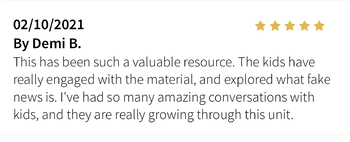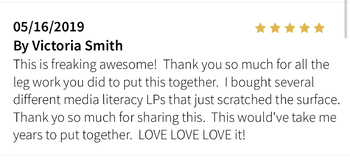Fake News: Evaluating Reliable & Credible Sources Online | Evaluating Websites
- Zip
- Google Apps™
- Internet Activities

What educators are saying
Description
Want to teach your students scientifically-based lessons on how to stop the spread of fake news by recognizing unreliable sources but don't have the time to develop plans on this ever-developing topic?
We all know that it is essential to teach our students to recognize fake news, or misinformation and disinformation, especially if they’ll be voting soon, but it’s so hard to teach the higher level thinking that is required to navigate today’s media.
If someone tells you that you can teach your students to evaluate a website with a checklist, they're either lying to you or they're unqualified to teach the skills that your students need.
Back in 2016, when Stanford University first started testing students on their ability to recognize fake news, the results were pretty shocking. Researchers describe the results of their study done on middle school, high school, and college students across the country “in one word: bleak.” Since then, many schools have started to mandate the study of digital literacy. Unfortunately, those efforts haven’t resulted in much progress. In fact, when Stanford did a similar study in 2019, they found that little had changed, and that students who had been taught to use a checklist like the C.R.A.P method for evaluating sources could be misled "by focusing their attention on a single site instead of teaching them how to consult the broader web to establish a site’s trustworthiness."
The information that your students gain from the internet will be used to make major decisions in their lives, and even decisions that will decide the fate of the country as a whole. This topic is too important to simply “cover” before you quickly move on to the next requirement.
Even worse, when students get a false sense of confidence because they have completed a short unit or filled out a simplistic handout, the lack of critical thinking that results from thinking that they are too smart to fall for fake news will make them even more likely to fall for the slick websites and duplicitous sources out there.
If students are going to stop the spread of fake news, they’re going to need to develop the kind of critical thinking skills that only come from lots of practice based on actual research into how professional fact checkers evaluate online sources. This comprehensive unit has been completely overhauled and now incorporates the most up-to-date research.
This unit has what you need to truly help your students become lifelong critical thinkers and confident skeptics who are able to make positive decisions based on the facts.
When you teach your students to think critically with this innovative unit you will:
- Begin each class period with engaging opening exercises designed to get your classes calm, focused, and thinking about the essential questions of the unit.
- Get your classes thinking like fact checkers when they learn and practice the essential skill of reading laterally to evaluate online sources.
- Engage different learning styles by incorporating group work, partner activities, quiet writing and reflection, and full-class discussion.
- Easily teach this complicated topic with minimal prep and no previous knowledge when you utilize the extensive answer keys, print-and-go handouts, concrete activities, and structured pacing guide for every day of the unit.
- Engage your most jaded and challenging students when you teach with the fun quizzes, practical activities, fascinating TED Talks, and funny and informative videos.
- Teach your students to become better critical thinkers in all areas of their lives when they learn about how their emotions and cognitive biases effect their decision making.
- Prepare your students to engage independently with websites and online sources when you give them lots and lots of practice to develop the skills learned in the unit.
- Feel confident that you are teaching your students the best methods you can when you teach a unit based on the most recent research.
- Easily teach the unit online using the ready-to-go instructions, links, handouts, and forms all optimized for Google Classroom.
- Give your classes meaningful assessments when you choose from informational posters or videos, an argument essay, a creative writing assignment, or an opinion article.
- Easily grade students’ tests and projects when you utilize the rubrics and answer keys included here.
- Give our next generation of leaders the skills they need to make important decisions based on the best information available.
Read on below for more about how this comprehensive unit on fake news will bring your students’ critical thinking skills to the next level.
Why Does Fake News Matter? Before you delve into the complicated realms of brain science, emotions, and critical thinking, you’ll need to get your students’ buy-in. The first part of this unit will focus on how fake news does real harm and why it is all of our responsibility to do something about it.
What Do You Know? If your students are anything like mine, they probably don’t know as much as they think they do when it comes to mis- and disinformation. Getting them to confront their blind spots from the get-go will also help them to be more engaged in the coming lessons.
What Is Quality Journalism? We might assume that identifying quality journalism is as easy for our students as it is for us, but for teens who are accustomed to so consuming such huge quantities of media in their lives, it might not be so obvious. The next part of the unit will get students to explicitly understand the elements of quality journalism so that they know what they are looking for in their own reading.
What Is Fake News? With politicians and news reporters throwing the term “fake news” around left and right, it has become less and less clear what we mean when we say “fake news.” Giving students more nuanced terminology will help them move towards more of an understanding of the kinds of reporting they want to avoid.
Why Do We Love Fake News? So many of us are clicking and sharing before we even know what we’ve done. It’s important for your students to understand how their emotions and their brains contribute to appeal of fake news. Examining such topics such as emotional manipulation and cognitive bias will help to equip your classes with more of the tools that they need to think critically before they click and share.
How Can We Recognize Fake News? If your classes are using tools that were developed for the internet of 20 years ago, they don’t have what they need. The final and longest portion of this unit will teach students to analyze like a fact checker, reading laterally to answer three important questions: Who is behind this information? What is the evidence for their claims? What do other sources say about the organizations and its claims?
How Does Social Media Make Everything Even More Complicated? Recent polling done by Common Sense Media show that teens are twice as likely to get their news from social media than from news sources. When you add in factors like targeted advertising, complicated algorithms, and sites that make money off of clicking and sharing, it makes the whole mess of fake news even more challenging to navigate. But when students are armed with knowledge and awareness of how best to engage in social media, they’re more likely to pause, utilize the skills they’ve learned, and evaluate what they are reading using the tools of this unit.
Why Is It Important To Be a Skeptic And Not A Cynic? Before you send your students off into that strange world of the internet, it’s important to make sure that they understand how to be a skeptic, someone who questions or doubts, and not a cynic, someone who is so pessimistic about the possibility of finding trustworthy sources that they throw up their hands and see everything as suspicious.





